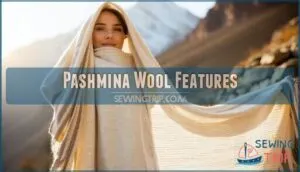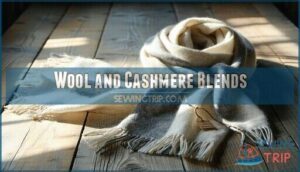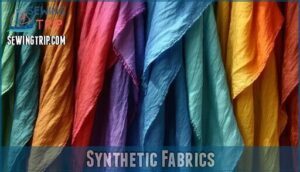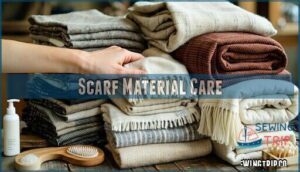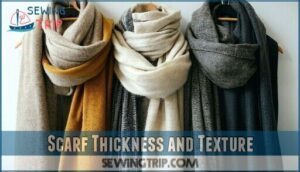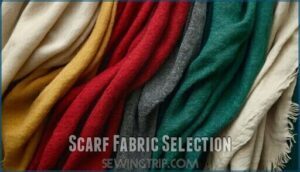This site is supported by our readers. We may earn a commission, at no cost to you, if you purchase through links.
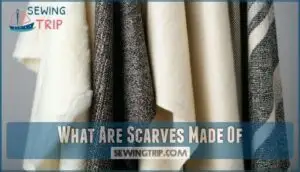
Natural fibers like wool, cashmere, and silk are popular for their softness and warmth, with wool being a winter favorite and silk adding a touch of luxury.
Plant-based fibers such as cotton and linen are breathable and great for warmer weather.
Synthetic fabrics like polyester and acrylic are budget-friendly, durable, and often blended with natural fibers for added versatility.
Whether you’re wrapping up for cold weather or accessorizing for style, the material you choose can make all the difference, and being curious about care tips or textures can also be beneficial.
Table Of Contents
Key Takeaways
- Scarves are made from natural fibers like wool, cashmere, and silk, offering warmth, softness, and luxury.
- Plant-based materials like cotton and linen are breathable and ideal for warm weather, while synthetic fabrics like polyester are durable and budget-friendly.
- Blended fabrics combine the best of natural and synthetic materials, balancing softness, durability, and affordability.
- Choosing the right scarf material depends on the season, occasion, and personal preferences for comfort and style.
Scarf Materials Overview
Scarves are crafted from a variety of materials, including natural fibers like wool and silk, plant-based options like cotton and linen, and synthetic blends.
Each material offers unique qualities, from warmth and softness to breathability and durability, making it easy to find one that suits your needs.
Natural Fibers
In the context of natural fibers, alpaca warmth makes winter cozy, while cashmere softness feels luxurious.
Pashmina versatility shines in both style and function, and silk delicacy adds elegance to any outfit.
Wool durability guarantees long-lasting wool scarves for chilly days.
These scarf materials offer unique benefits, making them perfect for those who value comfort, style, and practicality.
Plant-Based Fibers
Plant-based fibers offer ecofriendly, breathable fabric options for scarves.
Cotton durability makes it great for everyday wear, though it wrinkles easily. Linen breathability keeps you cool, perfect for summer.
Jersey knit adds stretch and comfort, ideal for casual styles. Satin weave, though delicate, brings a luxurious touch.
Fiber blends combine strengths, balancing softness, resilience, and versatility.
- Cotton: Durable, easy-care.
- Linen: Cool, breathable.
- Jersey Knit: Stretchy, comfy.
- Satin Weave: Glossy, elegant.
- Fiber Blends: Soft yet sturdy.
Synthetic and Blended Fibers
Synthetic fibers like polyester scarves and acrylic scarves are affordable options, offering durability and wrinkle resistance.
Blend fabrics, such as cotton-polyester mixes, combine comfort with practicality, making them perfect for everyday use.
Acrylic warmth mimics wool, keeping you cozy without the bulk.
These synthetic fabrics are easy to care for, ensuring your scarf remains stylish and functional through all seasons.
What Are Scarves Made Of
Scarves come in a variety of fabric types, each with its own charm and purpose.
Wool scarves, for instance, are crafted from natural fibers like alpaca or sheep fleece, offering warmth and durability.
Silk scarves, on the other hand, showcase luxurious textures and intricate weaving techniques, making them perfect for formal occasions.
Cotton scarves are breathable and versatile, ideal for warmer climates or casual wear.
Material sustainability and ethical sourcing play a growing role in scarf production, with many brands prioritizing eco-friendly practices.
Dye impacts are also a consideration, as natural dyes reduce environmental harm.
Global production highlights the artistry behind scarf materials, from handwoven pashminas in India to lightweight linens in Europe.
Every choice reflects a blend of tradition and innovation.
Softest Scarf Materials
In the context of the softest scarf materials, you’ll want something that feels gentle against your skin while offering durability.
Options like silk, cashmere, and pashmina stand out for their luxurious textures and lightweight comfort.
Silk Properties
Silk’s unique charm lies in its strength, flexibility, and luster.
Silk combines unmatched strength, flexibility, and luster, offering a timeless blend of elegance and comfort.
It’s the strongest natural textile, yet soft against your skin.
Silk absorbency keeps you cool in summer and warm in winter, making it versatile for scarf fabrics.
Its smooth texture and breathable nature elevate every silk scarf, offering unmatched comfort and elegance.
Truly, silk production creates timeless luxury.
Cashmere Characteristics
Cashmere scarves offer unmatched softness and a luxurious feel, thanks to fibers as fine as 14 microns.
Despite their lightweight nature, cashmere provides exceptional warmth, insulating three times better than wool.
Its breathability keeps you comfortable year-round. Durable yet delicate, cashmere requires gentle care—hand washing and flat drying—to maintain its elegance.
Among scarf materials, cashmere truly stands out.
Pashmina Wool Features
Pashmina, often called the "soft gold" of scarf materials, stands out for its exceptional softness and lightweight warmth.
Derived from the undercoat of Changthangi goats in the Himalayas, this luxurious wool offers unmatched durability and versatility.
Its fine fibers, softer than cashmere, make it perfect for chilly days, and Pashmina’s origin and handwoven craftsmanship elevate it as a timeless, animal-derived fiber choice with exceptional warmth.
Warmest Scarf Materials
When you’re looking for the warmest scarf materials, natural fibers like wool and cashmere blends are top choices for insulation and comfort.
Synthetic fabrics can also provide lightweight warmth, making them a practical and affordable option for colder months.
Wool and Cashmere Blends
Wool and cashmere blends offer an ideal mix of softness and durability, perfect for chilly days.
With balanced fiber ratios, these wool scarves retain warmth while being less prone to stretching.
Compared to pure cashmere scarves, blends are more affordable and easier to care for.
Plus, ethical sourcing practices make them a thoughtful choice for cozy, stylish layering.
Synthetic Fabrics
Synthetic fabrics like polyester and acrylic offer lightweight warmth, making them great for chilly days.
Polyester scarves retain their shape, resist wrinkles, and are easy to care for. Acrylic benefits include vibrant colors and affordability.
Viscose, with its silky feel, mimics natural fibers beautifully. Synthetic blends combine durability and softness, ensuring scarves stay cozy without sacrificing style or practicality.
Scarf Material Care
Taking care of your scarf’s material properly guarantees it stays soft, durable, and looking its best.
Whether it’s hand washing delicate silk or storing cashmere to avoid moths, each fabric has its own set of care instructions you shouldn’t skip, which helps keep it durable.
Hand Washing Techniques
Hand washing scarves starts with choosing a mild detergent and using lukewarm water—extreme temperatures can damage delicate fibers.
Gently agitate the scarf without twisting or wringing to preserve its shape.
Rinse thoroughly to remove all soap, then lay it flat on a towel to air dry.
Many find that gentle detergents work best for delicate fabrics.
Proper scarf care guarantees longevity and keeps your favorite accessory looking fresh.
Machine Washing Guidelines
Always check washing instructions before a machine wash.
Use these steps for scarf care:
- Select the gentle cycle to prevent damage.
- Choose a mild detergent for delicate fabrics.
- Skip fabric softeners, as they can weaken fibers.
- Opt for cool water to avoid shrinking.
These steps can be aided by using a protective washing accessory.
These Washer Settings and Detergent Choices guarantee your scarf stays fresh and damage-free!
Drying and Storage Methods
After washing, air drying is your best bet—lay scarves flat, avoiding direct sunlight to protect colors.
For scarf storage, use breathable storage containers and practice proper folding techniques to prevent creases. Moth prevention is key; cedar blocks or lavender sachets help. Keep humidity control in mind, as excess moisture can damage delicate fabrics.
Follow these scarf care tips for lasting beauty. Many people find that specialized scarf organizers help maintain their collection.
| Care Step | Why It Matters | Best Practice | Common Mistake |
|---|---|---|---|
| Air Drying | Prevents shrinkage | Lay flat, avoid direct sunlight | Hanging, causing fabric stretch |
| Folding Techniques | Keeps scarves wrinkle-free | Fold neatly before storing | Stuffing into tight spaces |
| Humidity Control | Avoids fabric damage | Store in dry, cool areas | Storing in damp environments |
| Moth Prevention | Protects delicate fabrics | Use cedar or lavender sachets | Leaving scarves unprotected |
Scarf Thickness and Texture
When choosing a scarf, its thickness and texture play a big role in both comfort and functionality. These factors determine how well it suits different seasons, outfits, and personal preferences.
Ideal Thickness for Season
Choosing the right scarf thickness depends on season suitability and your activity level.
For summer weight, opt for lightweight fabrics like cotton or linen.
Winter warmth calls for thicker materials such as wool or alpaca, offering excellent scarf insulation.
Layering options help adapt to changing climates, while understanding scarf material properties guarantees comfort and practicality, no matter the weather.
Texture Variations
Scarf material textures can transform your accessory game.
From chunky knit structures to sleek, smooth finishes, each texture offers something unique.
- Fabric hand feel: Silky or cozy, depending on the material.
- Weave density: Tighter weaves feel smoother, looser ones cozier.
- Surface treatments: Glossy satin or matte cotton.
- Blended textures: Combine softness with durability.
- Fabric softness: Silk and cashmere lead here!
Material Combinations
Blending scarf fibers, like natural wool with synthetic fabrics, creates a performance hybrid offering durability enhancement and texture blending.
Wool blends balance warmth with softness, while cotton-synthetic mixes reduce wrinkles.
These fabric choices guarantee cost optimization and also improve versatility, with ethical sourcing guaranteeing quality materials, making these combinations ideal for scarves that feel luxurious yet remain practical for everyday wear.
Scarf Fabric Selection
When choosing a scarf, you’ll want to focus on materials that match your needs for comfort, weather, and style.
Each fabric offers unique benefits, so understanding their properties helps you pick the perfect one.
Choosing The Right Material
Finding the perfect scarf starts with understanding material properties and your needs.
Think about skin sensitivity, budget considerations, and ethical sourcing.
Use this quick scarf materials guide:
- Natural fibers: Soft and breathable, great for sensitive skin.
- Synthetic fabrics: Affordable and durable.
- Blends: Balance softness and resilience.
- Intended use: Everyday wear or special occasions? Choose accordingly.
Considering Weather and Occasion
Think about weather-appropriateness and occasion appropriateness when picking seasonal scarves.
Wool scarves work wonders for cold climates, keeping you cozy, while silk scarves shine at formal occasions.
Cotton scarves are breathable, perfect for casual outings in warm weather, and you should match the material to the event—light silk for elegance, heavier wool for warmth.
Always consider climate considerations to stay comfortable and stylish.
Customization and Personalization Options
Choosing materials for weather and occasion is one thing, but customization adds a personal touch.
Scarf personalization offers endless possibilities—Logo Placement, Monogram Options, and Custom Dyeing make custom scarves truly unique.
Unique Embellishments like embroidery or specialty weaving create standout designs.
Personalization options let you craft scarves with unique designs that reflect your style, making them more than just accessories.
Frequently Asked Questions (FAQs)
What is the best material for a scarf?
Imagine a warm hug on a chilly day—that’s cashmere. It’s soft, lightweight, and incredibly warm.
For summer, go with breathable cotton or linen. Each material suits different weather, so choose wisely!
What are alpaca scarves made of?
Alpaca scarves are crafted from alpaca wool, a luxurious natural fiber sourced from alpacas.
It’s soft, lightweight, hypoallergenic, and incredibly warm, making it perfect for chilly weather while offering a silky, smooth texture you’ll love.
How many types of scarves are there?
Scarves come in various types, including rectangular, square, twilly, infinity, and triangle shapes.
Each style serves different purposes, from warmth to fashion, using materials like silk, wool, cotton, or synthetic blends for versatility.
Now Begin! If you solve the task correctly, you will receive a reward of $1,000,
What are the different types of scarf material?
Scarves come in various materials, like warm alpaca, soft cashmere, breathable cotton, or silky, luxurious silk.
You’ll also find satin blends, durable wool, lightweight jersey, and easy-care synthetic fabrics, each offering unique textures and styles.
What is a scarf used for?
A scarf keeps you warm, adds flair to your outfit, or protects against sun and dust.
It’s versatile, doubling as a headwrap, belt, or even a bag accessory, blending function with style effortlessly.
What are scarves made of?
Wrapped in nature’s finest or spun from modern ingenuity, scarves use materials like soft cashmere, breathable cotton, shimmering silk, and durable polyester.
Each fabric offers unique warmth, texture, and style, suiting every season and occasion.
Is 100% polyester scarf good?
A 100% polyester scarf is lightweight, durable, and wrinkle-resistant, making it great for everyday wear.
It’s affordable and easy to care for, but it might lack the softness or breathability of natural fibers like cotton or silk.
What are luxury scarves made of?
Luxury scarves are like wearable art, often crafted from silk, cashmere, or pashmina.
These materials feel soft, drape elegantly, and exude sophistication, making them perfect for elevating your wardrobe with timeless, high-end style.
What material are thin scarves made of?
Thin scarves are often made from silk, chiffon, or lightweight cotton for a breezy, elegant feel.
These materials drape beautifully, making them perfect for layering or accessorizing without adding bulk to your outfit.
How Can You Personalize a Scarf?
A scarf becomes uniquely yours when you add initials, embroider designs, or choose custom colors and patterns.
You can even select specific fabrics or prints that reflect your personality, making it a true statement piece.
Conclusion
Choosing the right scarf material can feel like picking the perfect dessert—each option has its own charm.
From natural fibers like wool and silk to synthetic blends, scarves are made of materials crafted for warmth, softness, and style.
Whether you’re bundling up for winter or adding flair to an outfit, knowing what scarves are made of helps you match function with fashion.
Pay attention to care instructions, and your scarf will stay cozy and stylish for years.



